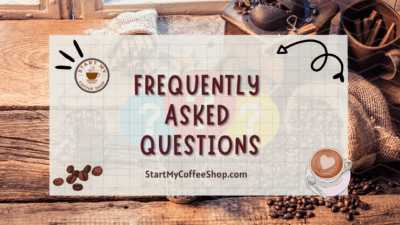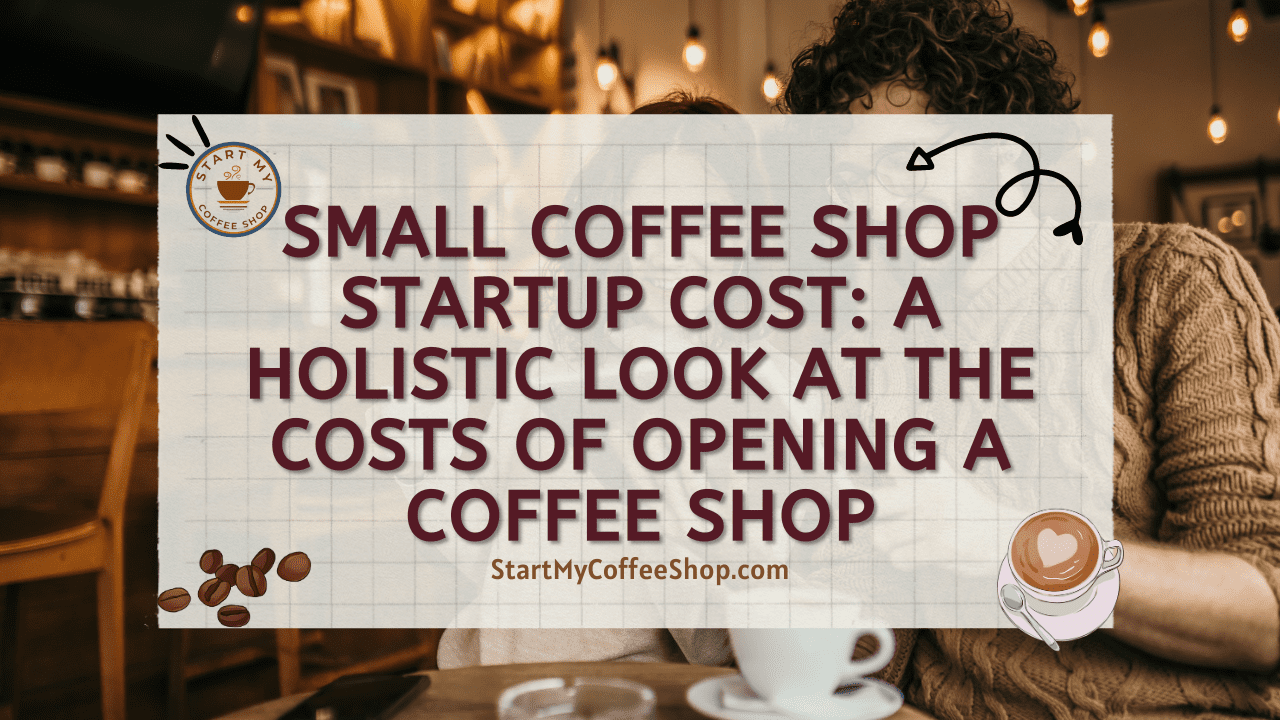Starting a small coffee shop can be an exciting venture for coffee enthusiasts and entrepreneurs alike. However, it’s crucial to have a clear understanding of the startup costs involved.
The estimated startup costs for opening a small coffee shop can range from $10,000 to $50,000, depending on factors such as location, size, equipment, renovations, permits, licenses, inventory, and marketing expenses.
In this article, I will delve into the various factors that contribute to the financial requirements of opening a small coffee shop.
1. Location and Lease:
It sets the stage for attracting customers and establishing a loyal clientele. When considering potential locations, several factors come into play that can impact the cost of leasing or purchasing a suitable space. These factors include the city’s economic environment, the neighborhood’s foot traffic and demographics, the size of the property, and the overall condition of the space.
In bustling cities, prime locations with high visibility and heavy foot traffic tend to come at a premium price. On the other hand, if you opt for a quieter neighborhood or a less popular area, you may find more affordable leasing or purchasing options. Additionally, the size of the space will influence the cost, with larger areas typically commanding higher rents or purchase prices.
It’s important to include rent or mortgage payments as ongoing expenses in your financial projections. This ensures that you have a clear understanding of the fixed costs you’ll need to cover regularly. By accurately budgeting for these expenses, you can better assess the financial feasibility of your coffee shop and make informed decisions about pricing, staffing, and other aspects of your business.
Remember, while securing an ideal location can be a significant investment, it can also yield long-term benefits by attracting more customers and enhancing the overall profitability of your coffee shop. So, take the time to thoroughly research and evaluate potential locations, considering both the cost and the potential return on investment.
2. Renovations and Interior Design:
Creating a warm and inviting ambiance in your coffee shop often involves renovations and interior design enhancements. These improvements encompass various aspects such as flooring, lighting, plumbing, seating, counters, and other aesthetic elements. The extent of the renovations required and the materials chosen greatly influence the associated costs.
Flooring options range from durable tiles to hardwood or laminate surfaces, each with its price point. Lighting fixtures play a crucial role in setting the desired mood, with options varying from recessed lighting to stylish pendant lights. Plumbing may need to be adjusted or installed to accommodate coffee machines, sinks, and restroom facilities.
The selection of seating, whether it be comfortable chairs, cozy booths, or communal tables, contributes to the overall atmosphere. Additionally, countertops and display areas should be functional, visually appealing, and aligned with the overall theme of your coffee shop.
The cost of renovations hinges on factors such as the size of the space, the complexity of the desired changes, and the quality of materials used. It is advisable to consult with professionals, such as contractors and interior designers, to accurately estimate the expenses involved and ensure that your vision aligns with your budget.
3. Equipment and Furnishings:
Investing in coffee shop equipment is a crucial aspect of setting up your business. It encompasses a range of essential items such as espresso machines, grinders, brewers, blenders, refrigerators, and more. The specific equipment requirements will depend on factors such as the size of your shop and the menu offerings you plan to provide.
Espresso machines are the heart of any coffee shop, and the cost can vary greatly depending on the brand, features, and capacity. Grinders are necessary for achieving the perfect grind consistency, and their quality directly affects the flavor of your coffee. Brewers are essential for drip coffee, while blenders are needed for crafting delicious blended beverages.
Refrigeration units are vital for storing perishable items like milk, cream, and syrups at the appropriate temperatures. Additionally, furniture and decor contribute significantly to the overall ambiance of your coffee shop. Comfortable tables and chairs, cozy seating areas, and tasteful decor elements all play a part in creating a welcoming atmosphere that entices customers to stay and enjoy their coffee.
When selecting equipment and furnishings, consider factors such as durability, functionality, and aesthetic appeal. Opt for reliable brands that offer excellent customer support and warranty coverage. Additionally, it’s important to balance your budget with the equipment’s quality to ensure a solid return on investment.
By carefully selecting the right coffee shop equipment and furnishings, you can provide a high-quality experience to your customers, enhance your operational efficiency, and ultimately contribute to the long-term growth of your small coffee shop.
4. Licenses, Permits, and Legal Fees:

Operating a coffee shop involves navigating through a maze of licenses and permits. These include health permits, business licenses, and food handling certifications, among others. The costs associated with obtaining these legal requirements can vary significantly depending on your location and the specific regulations in place.
To ensure compliance with local laws, it is essential to consult with the relevant local authorities or regulatory agencies. They can guide the specific permits and licenses required for your coffee shop. Additionally, they can outline the necessary steps for obtaining these legal requirements and inform you of any associated fees.
Budgeting for legal fees is a crucial aspect of your coffee shop’s financial planning. Consider the costs of application fees, renewal fees, and any inspections or assessments that may be required. By setting aside funds for legal expenses, you can avoid any surprises and ensure that your coffee shop operates within the legal framework.
Remember, obtaining the necessary licenses and permits is not only a legal obligation but also an important step in building trust and credibility with your customers. Compliance with health and safety regulations demonstrates your commitment to providing a safe and hygienic environment for your patrons.
Read more about Cost to Start Dunkin’s Coffee Shop: Analyzing the Cost Factors
5. Inventory and Supplies:
To satisfy the cravings of your customers, it is essential to ensure a well-stocked inventory in your coffee shop. This includes coffee beans, tea leaves, milk, syrups, and other ingredients necessary to create a diverse range of menu items. The cost of your initial inventory and ongoing supplies will be influenced by factors such as the volume of business and the variety of items you offer.
The selection of quality coffee beans or tea leaves is crucial to delivering a satisfying beverage experience to your customers. The cost of these primary ingredients can vary depending on factors such as the origin, quality, and sourcing practices. Additionally, you’ll need to factor in the cost of milk, alternative dairy products, sweeteners, flavor syrups, and any other components specific to your menu offerings.
In addition to the core ingredients, it’s important to consider the purchase of disposable cups, napkins, stirrers, and other essentials that contribute to a smooth and convenient customer experience. These items should be factored into your ongoing supply expenses.
Proper inventory management is key to controlling costs and minimizing waste. Regular monitoring of inventory levels, tracking popular menu items, and adjusting your purchasing patterns accordingly can help optimize your inventory and minimize unnecessary expenses.
6. Marketing and Advertising:
Promoting your coffee shop is a crucial element in attracting customers and building a strong customer base. Marketing costs encompass various activities aimed at creating awareness and generating interest in your establishment.
These expenses can include designing a logo that represents your brand’s identity, and developing and maintaining a user-friendly website that showcases your offerings and provides essential information to potential customers.
Printing menus and promotional materials such as flyers, brochures, and business cards are essential for offline marketing efforts. These materials help spread the word about your coffee shop within the local community.
Additionally, investing in online advertising campaigns allows you to target a wider audience and increase your online visibility. This can involve pay-per-click (PPC) ads, display ads, or sponsored social media posts.
Establishing a strong presence on social media platforms is crucial in today’s digital age. Allocating resources for social media campaigns can help engage with potential customers, share updates, and showcase the unique aspects of your coffee shop.
Furthermore, local advertising initiatives such as collaborations with neighboring businesses, participation in community events, or supporting local charities can help foster a positive reputation and gain the support of the local community.
7. Staffing and Training:
When planning to open a coffee shop, it’s important to factor in the costs associated with hiring and training employees. Staffing expenses encompass wages, benefits, uniforms, and training programs. The actual costs will depend on the size of your coffee shop and the number of employees required to efficiently handle operations. Providing competitive wages and benefits can help attract and retain talented staff members.
Additionally, investing in thorough training programs ensures that your employees are equipped with the necessary skills to deliver exceptional customer service and maintain consistent quality in beverage preparation. By carefully budgeting for staffing costs, you can ensure that you have the necessary resources to assemble a skilled and motivated team that will contribute to the progress of your small coffee shop.
8. Utilities and Overhead Expenses:
Running a coffee shop requires essential utilities such as electricity, water, gas, and internet connectivity. These utilities are vital for the day-to-day operations of your establishment. It’s crucial to consider the costs associated with these utilities when creating your financial plan.
Furthermore, other overhead expenses should be taken into account, including insurance to protect your business, accounting services to ensure financial accuracy and point-of-sale systems for smooth transactions. Allocating a budget for these necessary expenses ensures that you can cover the ongoing costs of utilities and overheads, allowing your coffee shop to operate efficiently and effectively.
By accurately estimating and planning for these expenses, you can avoid surprises and maintain a stable financial foundation for your small coffee shop.
9. Contingency and Miscellaneous Expenses:
Allocating a portion of your budget for unforeseen expenses and emergencies is a prudent step when starting a coffee shop. Establishing a contingency fund serves as a safety net, enabling you to handle unexpected challenges that may arise during the early stages of your business.
Unforeseen circumstances, such as equipment breakdowns, sudden repairs, or fluctuations in market conditions, can impact your finances. By setting aside funds specifically for contingencies, you have a financial cushion to address these situations without derailing your operations or straining your resources.
A contingency fund provides peace of mind and flexibility, allowing you to adapt and overcome unexpected hurdles while maintaining stability and long-term sustainability for your small coffee shop.
Summary
Opening a small coffee shop requires careful financial planning. By considering the various aspects discussed in this guide, you can estimate the startup costs involved and create a realistic budget.
Remember to conduct thorough research, seek professional advice when necessary, and continuously monitor and adjust your financial projections as your coffee shop evolves. With passion, dedication, and a sound financial foundation, your small coffee shop can flourish and become a beloved gathering place for coffee lovers in your community.
Frequently Asked Questions

What are the essential equipment and furnishings needed for a coffee shop?
Key equipment for a coffee shop includes espresso machines, grinders, brewers, refrigerators, and other appliances. Furnishings like tables, chairs, and decor are also important to create a welcoming atmosphere for customers.
Are there any legal requirements or permits needed to open a coffee shop?
Yes, operating a coffee shop typically requires obtaining various licenses and permits, such as health permits, business licenses, and food handling certifications. The specific requirements vary depending on your location and local regulations.
How can I estimate the ongoing expenses after opening a coffee shop?
You’ll need to consider ongoing expenses such as rent or mortgage payments, utilities (electricity, water, gas), supplies (coffee beans, ingredients, disposable items), staffing costs, marketing expenses, and overhead expenses (insurance, accounting services).
To learn more on how to start your own coffee shop checkout my startup documents here
Please note: This blog post is for educational purposes only and does not constitute legal advice. Please consult a legal expert to address your specific needs.

Hi! I’m Shawn Chun
My adventure in coffee began when I first launched my first coffee shop back in the early 2000s. I had to figure out so many things on my own and to make it worse within 2 years of opening two large corporate coffee chains moved in just blocks away from me!
As I saw smaller and even some larger coffee shops in the neighborhood slowly lose customers to these giant coffee chains and slowly close up shop, I knew that I had to start getting creative…or go out of business.
I (like you may be) knew the coffee industry well. I could make the best latte art around and the foam on my caps was the fluffiest you have ever seen. I even had the best state-of-the-art 2 group digital Nuova Simonelli machine money could buy. But I knew that these things alone would not be enough to lure customers away from the name brand established coffee shops.
Eventually, through lots of trial and error as well as perseverance and creativity I did find a way to not only survive but also thrive in the coffee/espresso industry even while those corporate coffee chains stayed put. During those years I learned to adapt and always faced new challenges. It was not always easy, however, in the end, I was the sole survivor independent coffee shop within a 10-mile radius of my location. Just two corporate coffee chains and I were left after that year. All told the corporate coffee chains took down over 15 small independent coffee shops and kiosks and I was the last one standing and thriving.
Along the years I meet others with the same passion for coffee and I quickly learned that it is not only “how good a barista is” that makes a coffee shop successful, but the business side of coffee as well.
Hence why I started this website you are on now. To provide the tools and resources for up and coming coffee shop owners to gain that vital insight and knowledge on how to start a coffee shop successfully.
Stick around, browse through my helpful blog and resources and enjoy your stay! With lots of LATTE LOVE!
Shawn







